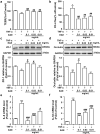Galli gigeriae endothelium corneum: its intestinal barrier protective activity in vitro and chemical composition
- PMID: 33593395
- PMCID: PMC7885590
- DOI: 10.1186/s13020-021-00432-3
Galli gigeriae endothelium corneum: its intestinal barrier protective activity in vitro and chemical composition
Abstract
Background: Galli gigeriae endothelium corneum (GGEC) has been effectively used for centuries for the treatment of functional dyspepsia (FD) in clinical practice in Asian countries. However, its potential mechanism and chemical composition remains undertermined.
Methods: In this study, the chemical profile of GGEC ethyl acetate extract (EAE) was evaluated by HPLC-Q-TOF-MS/MS. The effects of EAE on intestinal barrier function and inflammation were investigated in IEC-6 cells and RAW264.7 cells.
Results: The results showed that 33 compounds were tentatively identified, including 12 soy isoflavones, 7 bile acids for the first time in EAE. EAE significantly reinforced intestinal barrier function via increasing the tight junction protein levels of ZO-1 and Occludin, reducing the mRNA expression levels of interleukin (IL)-1β and IL-6 in tumor necrosis factor alpha (TNF-α)-challenged IEC-6 cells. The scratch wound assay showed that EAE accelerated wound healing of IEC-6 cells. EAE evidently reduced the level of NO in a dose-dependent manner with an IC50 value of 18.12 μg/mL, and the mRNA expression of TNF-α, IL-1β, IL-6, iNOS and COX-2 in LPS-treated RAW264.7 cells.
Conclusion: This study revealed the intestinal barrier protective effects and chemical profile of GGEC, and the results indicated that GGEC strengthened the intestinal barrier by up-regulating protein expression of tight junctions and limiting inflammatory responses.
Keywords: Anti-inflammatory; Galli gigeriae endothelium corneum; Gastrointestinal barrier; HPLC-QTOF–MS/MS; Identification; Wound healing.
Conflict of interest statement
The authors declare that they have no competing interests.
Figures




References
-
- Peron G, Hidalgo-Liberona N, Gonzalez-Dominguez R, Garcia-Aloy M, Guglielmetti S, Bernardi S, Kirkup B, Kroon PA, Cherubini A, Riso P, Andres-Lacueva C. Exploring the molecular pathways behind the effects of nutrients and dietary polyphenols on gut microbiota and intestinal permeability: a perspective on the potential of metabolomics and future clinical applications. J Agric Food Chem. 2020;68:1780–1789. - PubMed
-
- Omonijo FA, Liu S, Hui Q, Zhang H, Lahaye L, Bodin JC, Gong J, Nyachoti M, Yang C. Thymol improves barrier function and attenuates inflammatory responses in porcine intestinal epithelial cells during lipopolysaccharide (LPS)-induced inflammation. J Agric Food Chem. 2019;67:615–624. - PubMed
-
- He C, Deng J, Hu X, Zhou S, Wu J, Xiao D, Darko KO, Huang Y, Tao T, Peng M, Wang Z, Yang X. Vitamin A inhibits the action of LPS on the intestinal epithelial barrier function and tight junction proteins. Food Funct. 2019;10:1235–1242. - PubMed
Grants and funding
LinkOut - more resources
Full Text Sources
Other Literature Sources
Research Materials

